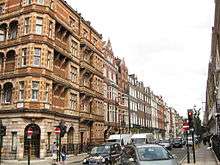Howard de Walden Estate
The Howard de Walden Estate is a property estate in Marylebone, London, owned by the Howard de Walden family. As of 2019 the estate was estimated to be worth £4.6 billion.[1]

History
The Estate's high value dates from 1715 when Edward Harley, 2nd Earl of Oxford and Earl Mortimer began the expensive, speculative development of Cavendish Square in London, and the streets around it.
It had been the semi-rural manor of Marylebone belonging to his wife's ancestors, the Dukes of Newcastle. This passed from Margaret Holles, née Cavendish, daughter of the 2nd Duke of Newcastle, to her daughter Henrietta Cavendish Harley. At the death of Henrietta's husband, the 2nd Earl of Oxford and Earl Mortimer, in 1741, this new Harley Estate passed to his only daughter, Margaret Cavendish Harley, who in 1734 had married William Bentinck, 2nd Duke of Portland. It thus became known as the Portland Estate, and passed to successive Dukes in the family. In 1879, the 5th Duke of Portland died without issue and his estates were divided between his sisters, according to the terms of the 4th Duke's will, and his cousin, who succeeded him as the sixth Duke. The estate eventually passed to the last surviving sister, Lucy Ellis, who was the widow of the 6th Lord Howard de Walden and has remained, subject to own trustee-imposed protective restrictions, in that cognatic branch of the same family since. This marked its second cognatic succession, i.e. through women.[2]
Property
The Estate covers 92 acres in which it holds the freehold to over 850 properties. As to homes, the Estate has mainly let them on long leases, which means it holds a minor, overarching interest. The main area extends north to Marylebone Road, west to Hallam Street and south to Wigmore Street.[3] Its majority stake in the far east of Marylebone (bordering Fitzrovia) was sold in 1925 to Sir John Ellerman,[4][5] which interests are now owned by the Langham Estate.[6] The Estate includes property on Marylebone High Street and Harley Street.
In the 1990s the Estate took steps to revitalise the High Street, adding new shops including a Waitrose supermarket.[7]
See also
References
- "The Howard de Walden Estate outlines investment plan for medical zone". Evening Standard. 2019-09-04. Retrieved 2019-09-07.
- "HISTORY AND EARLY DAYS ON KINGSMEAD". Mkheritage.co.uk. Retrieved 12 October 2017.
- "Archived copy" (PDF). Archived from the original (PDF) on 2015-04-02. Retrieved 2015-03-19.CS1 maint: archived copy as title (link)
- UCL. "South-East Marylebone". The Bartlett School of Architecture. Retrieved 2018-10-16.
- Philip Temple & Colin Thom. "South-East Marylebone -- Draft chapters of Volumes 51 and 52" (PDF). Survey of London. Retrieved 15 Oct 2018.
- "History of The Langham Estate". Langham Estate. Retrieved 2018-10-16.
- "LANDLORD CHARGES : Kay & Co". Kayandco.com. Retrieved 12 October 2017.
External links
| Wikimedia Commons has media related to Howard de Walden Estate. |